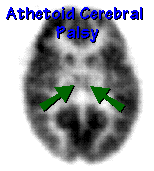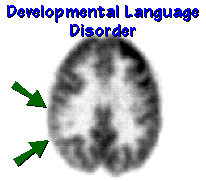[Menu] [Previous] [Next]
TUTORIAL: Clinical PET - Neurology
Use the "Menu" button to jump to the Let's Play PET Main Menu or click on the Next and Previous buttons to proceed sequentially through the topics and tutorials. Or, you can return to the Department of Molecular and Medical Pharmacology's Home Page.Contents:
Topics:
Developmental Errors

Click on image above to view full-size image.
In a neuronal migrational error, neurons fail to migrate to their proper final destination. In this neonatal patient, one sees that the cortical neurons have failed to reach the region outside the red boundary. The "clumping" of the neurons just inside the boundary produces a hypermetabolic signal in the PET image.

Click on image above to view full-size image.
In athetoid cerebral palsy, the thalamus fails to develop. Athetosis produces slow, writhing movements of the hands and fingers (and in some cases of the toes).

Click on image above to view full-size image.
This PET scan is from a patient with focal cortical dysplasia & epilepsy. The neurons in a focus of the cerebral cortex have developed improperly, resulting in a region of hypometabolism and producing epilepsy.

Click on image above to view full-size image.
In a developmental language disorder, one finds hypometabolism in the cortical region responsible for language.
Credits
Material for this section was kindly provided by:Michael E. Phelps, Ph.D.
Dept. of Molecular and Medical Pharmacology
UCLA School of Medicine
Harry T. Chugani, M.D.
Pediatric PET Center
Children's Hospital
Wayne State University
[Menu] [Previous] [Next]